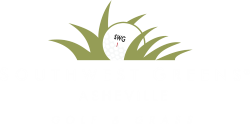Transforming Asheville Golf Courses with Artificial Turf
Golf has long been known as a game of precision and skill, played on perfectly manicured greens. However, the conventional methods of caring for golf courses come with their fair amount of challenges, such as significant water usage, extensive and time-consuming maintenance requirements, and susceptibility to weather conditions. Recently, there has been a revolutionary shift in the industry with the introduction of artificial turf, and Southwest Greens of Asheville has emerged as a forefront leader in this realm. In this blog, we will delve into the innovation behind artificial turf, exploring how it revolutionizes golf courses and why Southwest Greens is at the vanguard of this revolutionary approach.
THE HISTORY OF ARTIFICIAL GRASS
Artificial turf technology has come a long way since its inception in the ‘60s. Early versions were criticized for their less than natural appearance and lackluster playability. However, advancements in technology and materials have transformed artificial turf into a top-performing, visually appealing alternative to natural grass. Southwest Greens has been working hard to push the boundaries of technology that closely mimic the look, feel, and playability of natural grass.
WHAT MAKES TODAY’S SYNTHETIC TURF BETTER?
One of the critical aspects of Southwest Greens' artificial turf that stands out from the competition is its composition. It’s made of a multi-layered system manufactured to mimic the properties of natural turf. The top layer, often called the infill, is a mixture of fine-grained materials such as rubber, depending on the application. This layer provides stability, padding, and grip, enabling golfers to achieve consistent bounce, aim, and roll (B.A.R.).
Under the infill is a backing material that improves durability and ensures proper drainage. Southwest Greens' proprietary backing technology is engineered to withstand heavy foot traffic and resist damage, making it suitable for Asheville golf courses that experience high volumes of play.
THE SCIENCE OF ARTIFICIAL TURF
The science that goes into Southwest Greens' artificial turf goes beyond its composition. A critical aspect of its design is the integration of cutting-edge fibers that simulate the properties of genuine grass blades. These fibers are precisely engineered to provide a life-like appearance and ideal playing conditions. They are often made from polyethylene, which offer fantastic durability and resilience. Southwest Greens leverages extensive research and development to guarantee that its artificial turf products deliver reliable performance, even under demanding usage.
WHY ARTIFICIAL TURF INSTEAD OF NATURAL GRASS?
One of the primary benefits of synthetic turf over natural grass is its negligible maintenance requirements. Maintaining a conventional golf course can be a time-consuming and costly endeavor. Natural grass demands consistent irrigation, regular mowing, regular fertilization, and pest control.
On the other hand, Southwest Greens' artificial turf does away with the need for these tasks. It’s designed to survive fluctuating weather conditions, including severe heat and heavy rainfall, without losing its structural integrity or playability. This resilience makes it a economical and sustainable alternative for Asheville golf courses, as it demands minimal water usage and reduces the need for harsh chemicals.
Southwest Greens' artificial turf gives a level of consistency that is challenging to achieve with natural grass. Golfers regularly struggle with uneven playing surfaces, inconsistent ball rolls, and divots caused by footsteps. With artificial turf, these issues are mitigated, providing golfers with a dependable and predictable playing experience. The advanced infill systems used by Southwest Greens ensure that the ball rolls smoothly and consistently, allowing players to focus on their technique and strategy.
WHAT ABOUT THE ENVIRONMENTAL EFFECTS OF ARTIFICIAL GRASS?
Beyond its performance features, artificial turf can also contribute to environmental sustainability. Water scarcity is a pressing issue in many regions, and golf courses are frequently criticized for their high water consumption. By migrating to artificial turf, Asheville golf course operators can substantially reduce their water usage, alleviating the strain on local water supplies.
The lack of harmful fertilizers and pesticides needed for natural grass maintenance helps minimize water pollution and soil contamination. Our company's commitment to sustainability is on display in its commitment to making environmentally friendly turf products that align with these principles.
THE DREAM TEAM OF SOUTHWEST GREENS
Our company’s expertise goes beyond the science of artificial turf. Our team of pros, including engineers, installers, and designers, really understand golf course architecture and construction. They work closely together with golf course owners and operators to build custom solutions to meet their specific needs and requirements. Whether it's designing a challenging artificial putting green or constructing an entire golf course, Southwest Greens combines scientific knowledge with hands-on expertise to deliver excellent final products.
